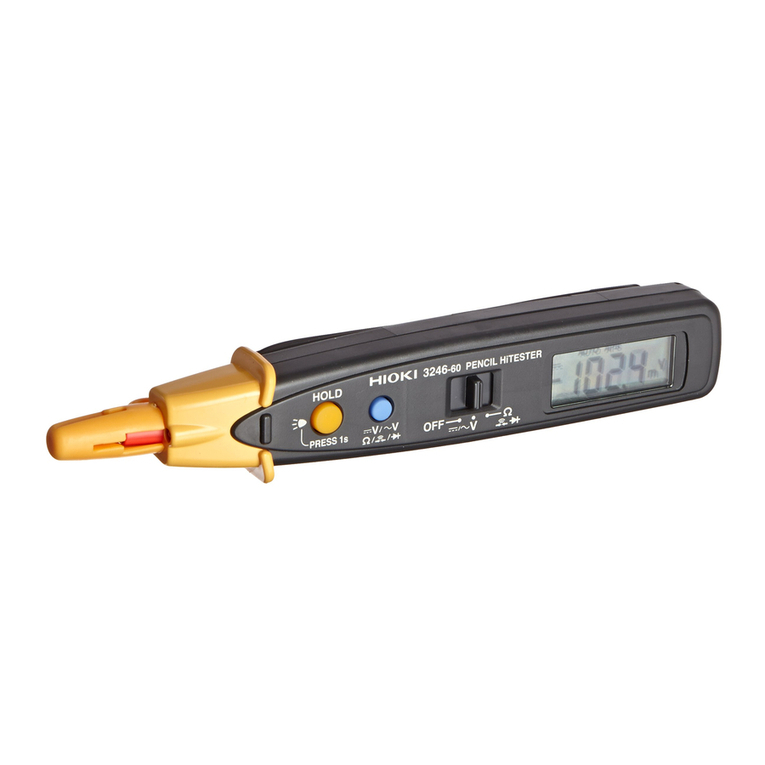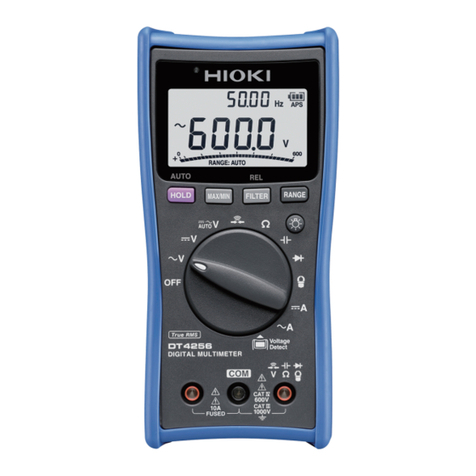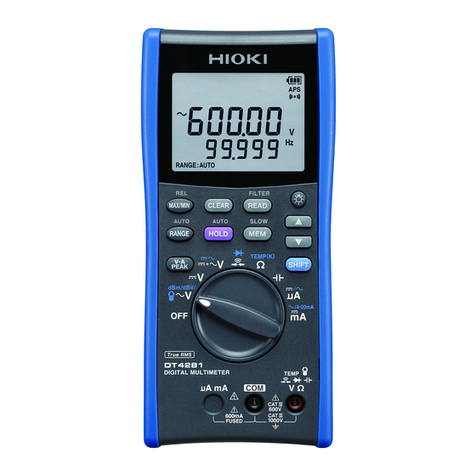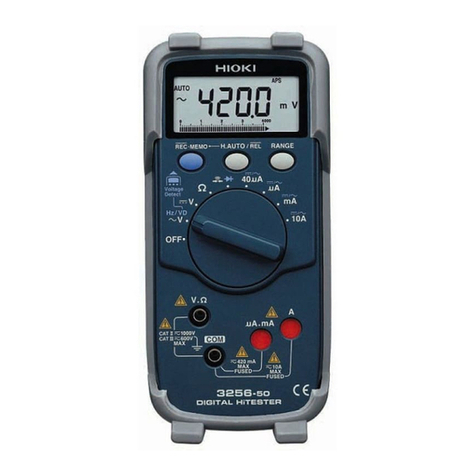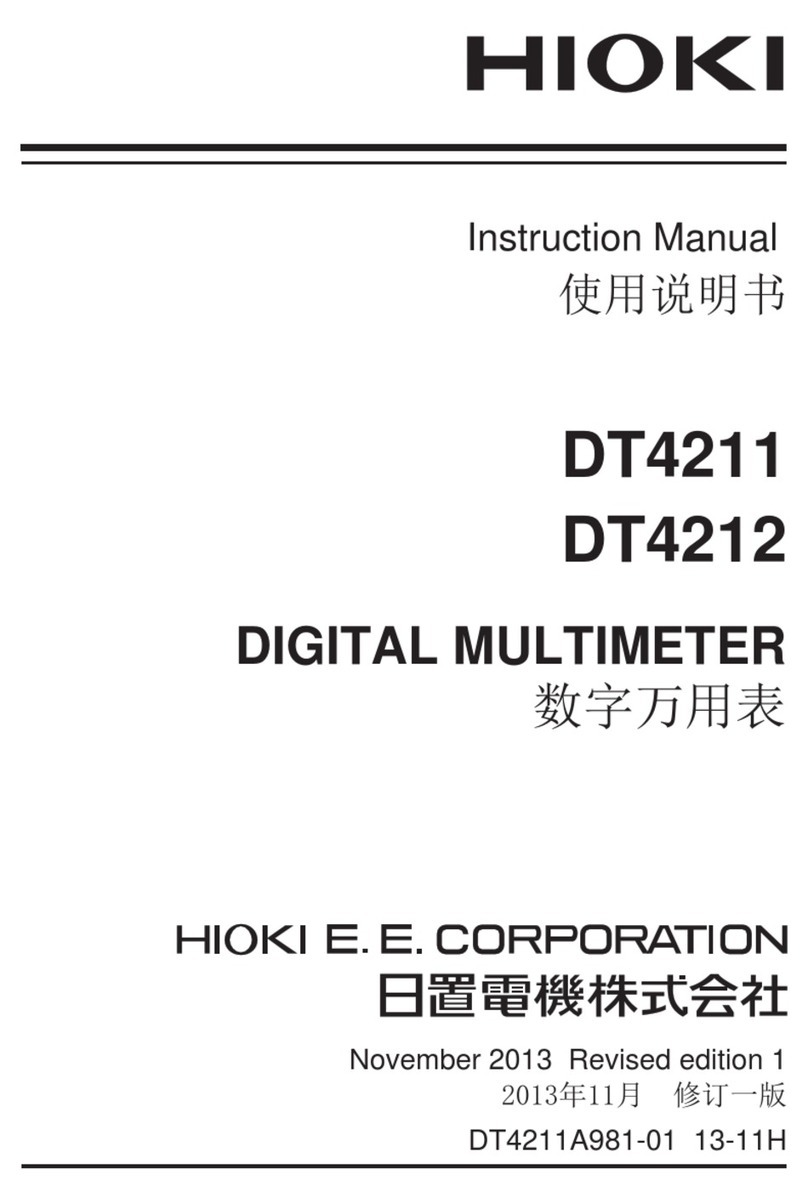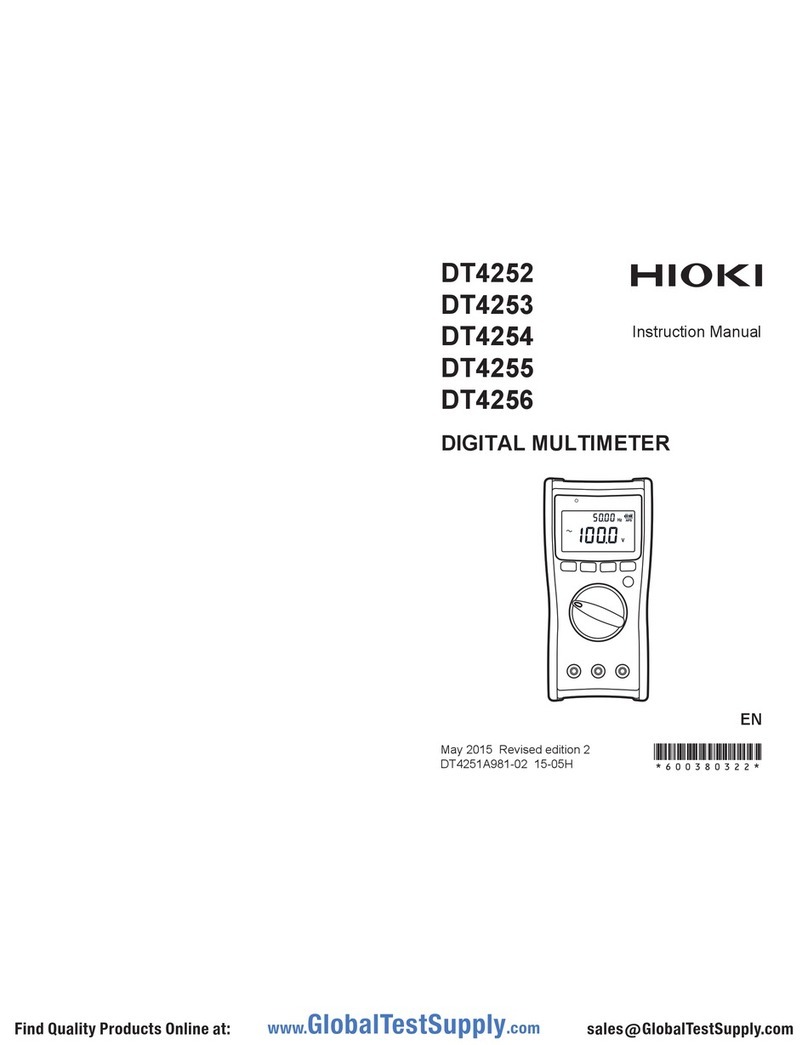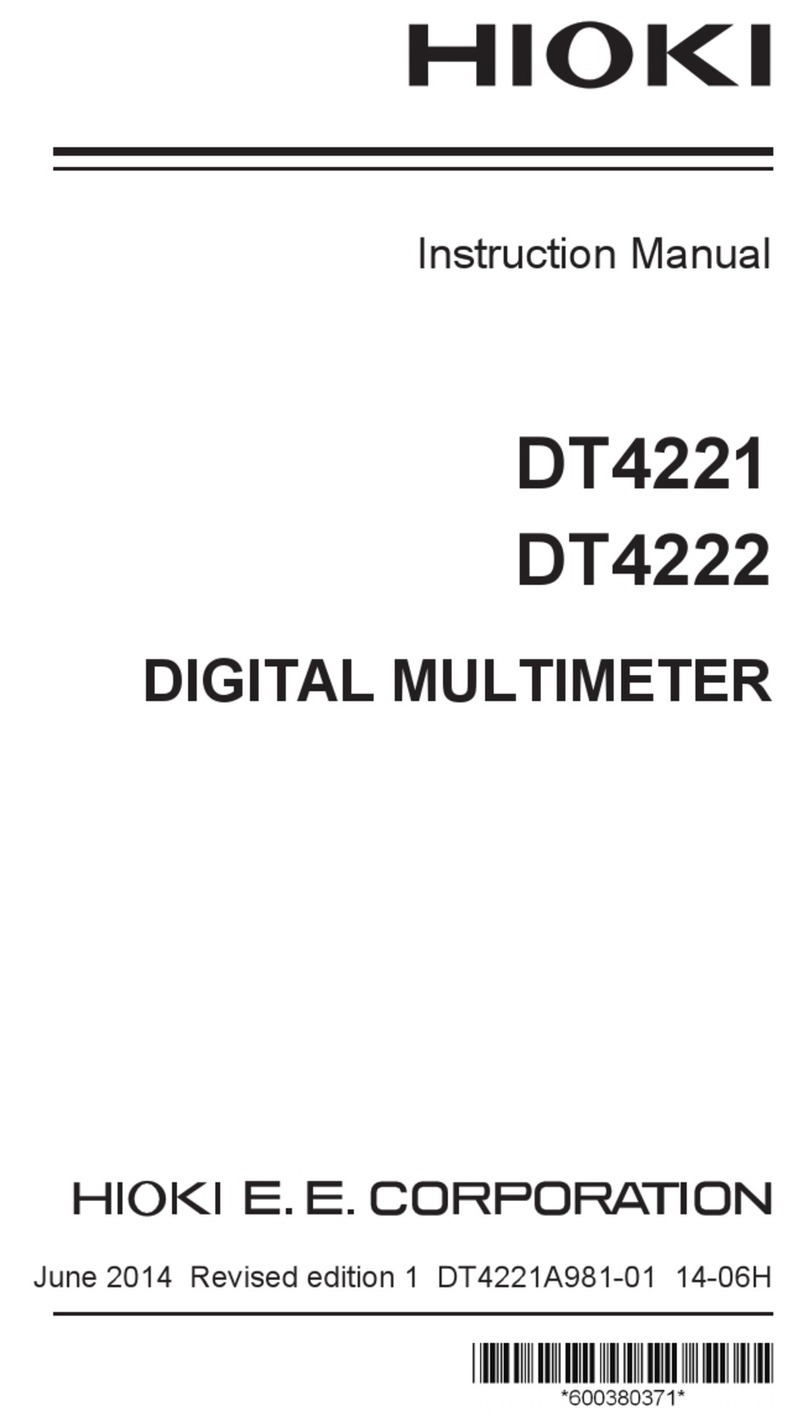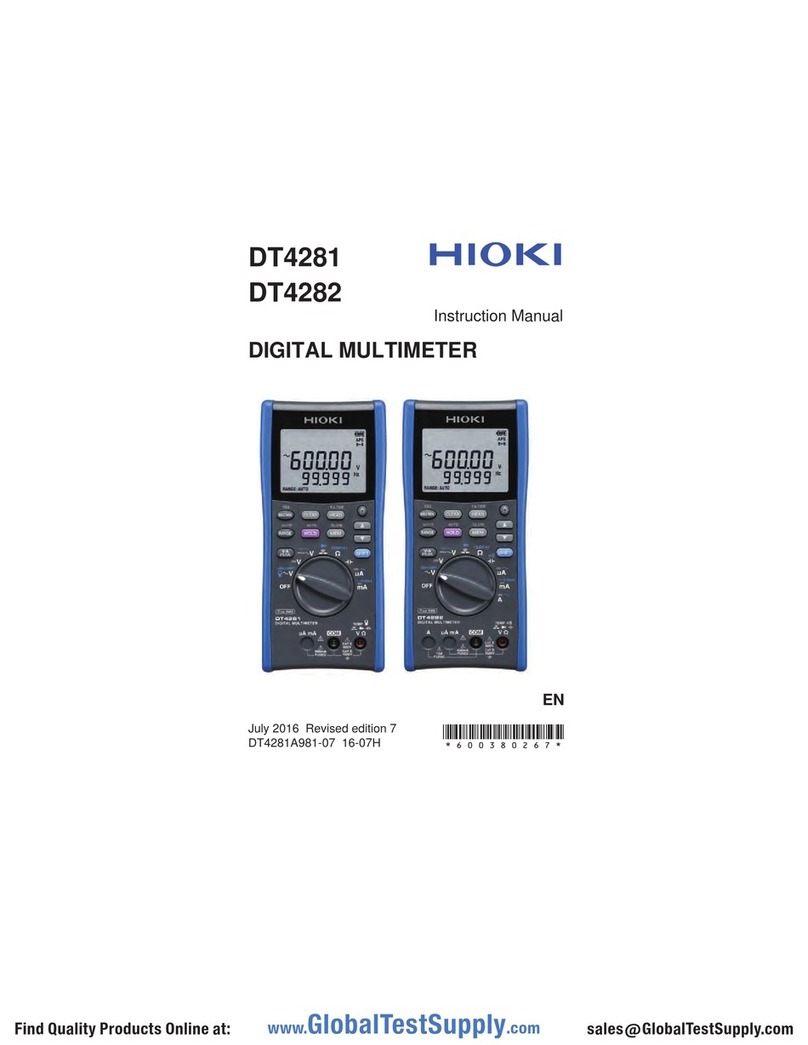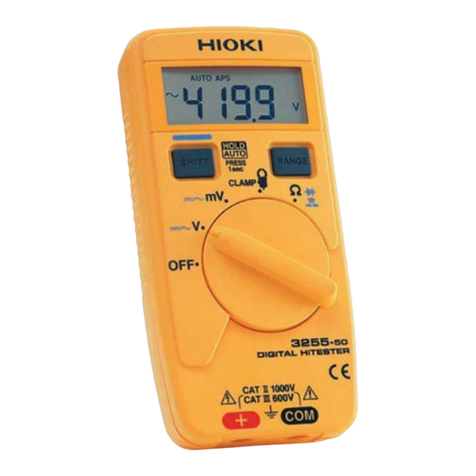123
Black(−)Red (+)
Red (+) Black(−)
Resistance Measurement [ ]
21 34
Continuity check [ ]
2134
Specifications
Accuracy
We define measurement tolerances in terms of rdg. (reading) and
dgt. (digit) valueswith the following meanings:
rdg.
(reading or
displayed value)
The value currently being measured and
indicated on the measuring instrument.
dgt.
(resolution)
The smallest displayable unit on a digital
measuring instrumenti.e.the input value
that causes the digital display to show a “1”
as the least-significant digit.
Basic Specifications
Maximum input
current • Jaw (3280-10F3280-20F)
2000 AAC continuous (45 Hz to 66 Hz)
• Flexible loop
(3280-10F+CT6280 or 3280-20F+CT6280)
4200 AAC continuous (50 Hz to 60 Hz)
Maximum input
voltage
600 V AC/DC and 3×106V·Hz or less (ACV/DCV)
Overload
protection 600 V AC/DC (ACV/DCV/Ω/continuity)
Maximum
rated voltage
to earth
• JawCT6280
600 V AC (Measurement category III)
300 V AC (Measurement category IV)
(Anticipated transient overvoltage: 6000 V)
• Voltage measurement terminal
600 V AC (Measurement category II)
300 V AC (Measurement category III)
(Anticipated transient overvoltage: 4000 V)
AC
measurement
method
3280-10F
Average value measurement RMS method
3280-20F True RMS measurement method
Display update
rate 400 ms±25 ms
Noise rejection
characteristics NMRR DCV −40 dB or more (50 Hz/60 Hz)
CMRR DCV −100 dB or more
(−50 Hz/60 Hz1 kΩunbalance)
ACV −60 dB or more
(50 Hz/60 Hz1 kΩunbalance)
But−45 dB or more for 600 V range.
Crest factor
(3280-20F only) For 2500 counts or less2.5
Reduces linearly to 1.5 or less at 4200 counts
Zero-display
range 5 counts (AC Currentjaw - flexible loop)
Effects of
conductor
position
• 3280-10F3280-20F: within ±5.0%
• CT6280: within ±5.0%
(At all positions around the sensor’s centerpoint reference)
Maximum
measurable
conductor
diameter
• 3280-10F3280-20F: 33 mm or less
• CT6280: 130 mm or less
General Specifications
Operating
environment Indoorspollution degree 2
altitude up to 2000 m (6562 ft.)
Operating
temperature
and humidity
• Temperature;
−25°C to 65°C (−13.0°F to 149.0°F)
(40 MΩrange: up to 40°C)
• Humidity (no condensation);
Less than 40°C (104.0°F): 80% RH or less
At least 40°C (104.0°F) but less than 45°C (113.0°F):
60% RH or less
At least 45°C (113.0°F) but less than 50°C (122.0°F):
50% RH or less
At least 50°C (122.0°F) but less than 55°C (131.0°F):
40% RH or less
At least 55°C (131.0°F) but less than 60°C (140.0°F):
30% RH or less
At least 60°C (140.0°F) but less than 65°C (149.0°F):
25% RH or less
Storage
temperature
and humidity
−25°C to 65°C (−13°F to 149°F)
80% RH or less (no condensation)
Dustproof and
waterproof IP40 (EN60529)
Drop-proof
distance 1 m on concrete
Standards Safety: EN61010
EMC: EN61326
Power supply CR2032 Coin-shaped lithium battery ×1 (3 V DC)
Maximum rated power: 15 mVA
Continuous
operating time • 3280-10F: Approx. 120 hours
• 3280-20F: Approx. 70 hours
(AC current measurement modecontinuousunloaded)
Dimensions
• 3280-10F3280-20F: Approx. 57W×175H×16D mm
(2.24″W × 6.89″H × 0.63″D)
• CT6280: Approx. 42W×65H×18D mm
(1.65″W × 2.56″H × 0.71″D)
(excluding the flexible loop and output cable)
Mass • 3280-10F3280-20F: Approx. 100 g (3.5 oz.)
(including battery)
• CT6280: Approx. 71 g (2.5 oz.)
Product
warranty period
3280-10F3280-20FCT6280: 3 years
Accessories • 9398 Carrying Case
(C0205 Carrying Case when CT6280 is attached)
• L9208 Test lead
• CR2032 Coin-shaped lithium battery
• Instruction Manual
Options • CT6280 AC Flexible Current Sensor
(Attachment is included)
• 9209 Test Leads Holder
• L4933 Contact Pin Set
(Can be connected to the tip of the L9208which
comes with the instrument.)
• L4934 Small Alligator Clip Set
(Can be connected to the tip of the L9208which
comes with the instrument.)
CALIFORNIAUSA ONLY
This product contains a CR Coin Lithium Battery which
contains Perchlorate Material - special handling may apply.
See www.dtsc.ca.gov/hazardouswaste/perchlorate
Function Specifications
Display Maximum count: 4199 counts
Battery indicator
warning voltage mark lights up at 2.3 V±0.15 V or less
Accuracy Specifications
Conditions of
guaranteed
accuracy
• Guaranteed accuracy period: 1 year (Number of jaw
and flexible loop open/close cycles: 10000 or less)
• Guaranteed accuracy period after adjustment
made by Hioki: 1 year
• Temperature and humidity for guaranteed accuracy:
23°C±5°C (73.0°F±9.0°F)80% RH or less
• Temperature characteristic: Measurement
accuracy × 0.1/°C is added (excluding 23°C±5°C)
AC Current - Jaw (3280-10F)
Range Accuracy range Accuracy
50 Hz ≤f ≤60 Hz
42.00 A 4.00 A to 41.99 A ±1.5% rdg.±5 dgt.420.0 A 40.0 A to 419.9 A
1000 A 100 A to 1000 A
AC Current - Jaw (3280-20F)
Range Accuracy range Accuracy
40 Hz ≤f <
45 Hz 45 Hz ≤f ≤
66 Hz 66 Hz < f ≤
1 kHz
42.00 A 4.00 A to 41.99 A ±2.0% rdg.
±5 dgt. ±1.5% rdg.
±5 dgt. ±2.0% rdg.
±5 dgt.
420.0 A 40.0 A to 419.9 A
1000 A 100 A to 1000 A
Accuracy is not defined for currents of 5×105A·Hz or more.
AC Current - Flexible loop (3280-10F)
Range Accuracy range Accuracy
50 Hz ≤f ≤60 Hz
420.0 A 40.0 A to 419.9 A ±3.0% rdg.±5 dgt.
(includes accuracy of CT6280 AC
Flexible Current Sensor: ±1.0% rdg.)
4200 A 400 A to 4199 A
AC Current - Flexible loop (3280-20F)
Range Accuracy range Accuracy
40 Hz ≤f <
50 Hz 50 Hz ≤f ≤
60 Hz 60 Hz < f ≤
1 kHz
420.0 A 40.0 A to 419.9 A ±3.5% rdg.
±5 dgt.*1*2±3.0% rdg.
±5 dgt.*1±3.5% rdg.
±5 dgt.*1*2
4200 A 400 A to 4199 A
*1: Includes accuracy of CT6280 AC Flexible Current Sensor: ±1.0%
rdg.
*2: Accuracy is not defined for currents of 1000 A or more or
currents of 5×105A·Hz or more.
AC Voltage
Range Accuracy range Accuracy Input
impedance
45 Hz ≤f ≤66
Hz 66 Hz < f ≤
500 Hz
4.200 V 0.400 V to 4.199 V ±1.8% rdg.
±7 dgt. ±2.3% rdg.
±8 dgt.
11 MΩ±5%
42.00 V 4.00 V to 41.99 V 10 MΩ±5%
420.0 V 40.0 V to 419.9 V 10 MΩ±5%
600 V 400 V to 600 V 10 MΩ±5%
DC Voltage
Range Accuracy range Accuracy Input impedance
420.0 mV 40.0 mV to 419.9 mV ±2.5% rdg.
±5 dgt. 100 MΩor more
4.200 V 0.400 V to 4.199 V ±1.0% rdg.
±3 dgt.
11 MΩ±5%
42.00 V 4.00 V to 41.99 V 10 MΩ±5%
420.0 V 40.0 V to 419.9 V 10 MΩ±5%
600 V 400 V to 600 V 10 MΩ±5%
Resistance
Range Accuracy range Accuracy
Open circuit
voltage
420.0 Ω40.0 Ωto 419.9 Ω
±2.0% rdg.±4 dgt. 3.4 V or
less
4.200 kΩ0.400 kΩto 4.199 kΩ
42.00 kΩ4.00 kΩto 41.99 kΩ
420.0 kΩ40.0 kΩto 419.9 kΩ
4.200 MΩ0.400 MΩto 4.199 MΩ±5.0% rdg.±4 dgt.
42.00 MΩ4.00 MΩto 41.99 MΩ±10.0% rdg.±4 dgt.
Continuity Check
Range Accuracy Threshold of
buzzer sound Open circuit
voltage
420.0 Ω±2.0% rdg.±4 dgt. 50 Ω±40 Ωor
less 3.4 V or less




